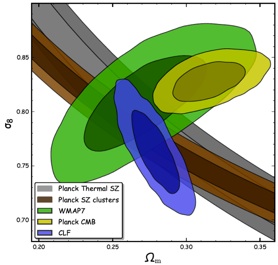
desert tree
Research




Using a combination of galaxy clustering and galaxy-galaxy lensing data from the Sloan Digital Sky Survey, we have put tight constraints on the cosmological matter density, Ωm, and the power spectrum normalization, σ8.
Precision Cosmology with Galaxies
Statistics of Dark Matter Substructure
This page describes a subset of the various projects I am currently involved in, or that have recently been completed...
Whereas the results are in good agreement with those from the 7-year data release from WMAP, they are inconsistent with the more recent Planck constraints. We are currently investigating the cause of this discrepancy, focussing on assembly bias and massive neutrinos.
Click here for the paper describing our results
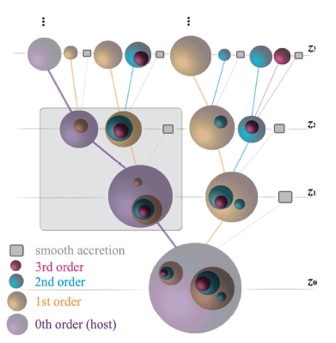
As a preamble, we tested and compared various EPS merger tree algorithm. The results of this study are presented in this paper.
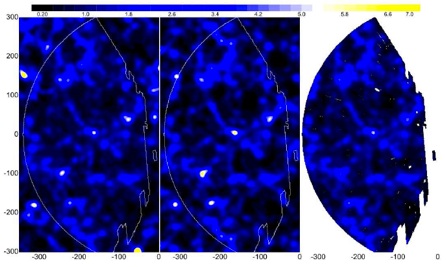

Next we developed a new method to reconstruct an initial, linear density field from its evolved, non-linear version. The above image shows a density field evolved, using N-body simulation, from linear initial conditions obtained using our reconstruction method. The middle panel is the original N-body simulation, and the right-panel is the evolved density field inferred from a group catalog constructed using the simulation in the middle panel. Click here for paper.
Having demonstrated that the method works, we our now running large N-body simulations using initial conditions reconstructed from the evolved density field inferred from our SDSS galaxy group catalogs. Stay tuned....
Simulating the Local Universe
The Mass Assembly of Galaxies


How do galaxies assemble their stellar mass across cosmic time? Despite a well formulated, 35 year-old framework of hierarchical structure formation, this basic question still begs for a satisfactory answer. We are using extremely simple models to gain valuable insights into this issue. This has resulted in the identification of a new characteristic redshift in galaxy formation, where a rapid transition occurs in the ability of low mass halos to form stars. This scales leaves an imprint in the mass function of low mass galaxies in clusters, and brakes the monotonicity in the `downsizing’ behavior of the galaxy population.
To learn more, have a look at our paper on the Evolution of the Galaxy-Dark Matter Connection, or that based on Empirical Modeling.
A few years ago we started the ELUCID project, the goal of which is to run a large numerical simulation using constrained initial conditions of the local Universe (roughly the volume covered by the SDSS Main Galaxy Sample. We first developed a new method to reconstruct the cosmic density field from the distribution of dark matter haloes, which are traced by galaxy groups. Click here for paper.
We are developing a new model for the substructure of dark matter haloes. Using accurate halo merger trees, and an analytical model for the average mass loss rate of subhalos as they orbit their host, the model yields the subhalo mass and velocity functions for subhalos of all different orders. Comparison with simulation results shows that the model is extremely accurate. We will use this model to revisit the too-big-to-fail problem, and to investigate to what extent the abundance of subhaloes obeys Poisson statistics.
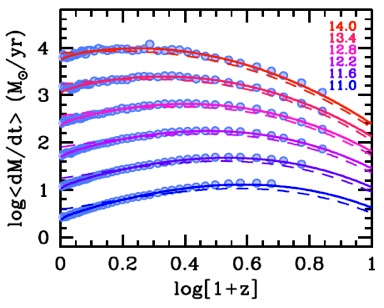
Coming of Age in the Dark Sector
We are studying how dark matter halos assemble their mass and grow their central potential wells. Using a combination of newly developed semi-analytical models and high-resolution numerical simulations we find that the growth of the central potential proceeds the assembly of mass, in that Vmax of the halo’s main progenitor is already half the present day value by the time it has accreted only ~2% of its final mass. We are find that the average mass accretion histories of dark matter haloes have a truly universal form, which we use to develop a new and improved analytical model for the
mass accretion rates.


Galaxy Assembly Bias & Conformity
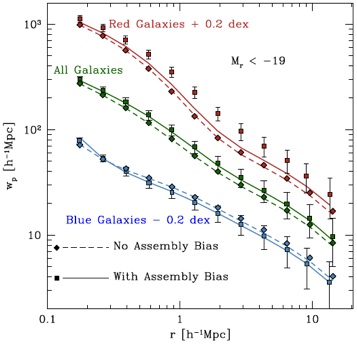
We are using a variety of different approaches to study whether and how galaxies display assembly bias, in that their properties depend on the assembly history of their host halo at fixed halo mass. Using mock galaxy catalogs, some with and some without galaxy assembly bias, we are testing how this phenomenon manifests itself observationally. In addition to having an impact on the clustering of galaxies (see this paper of ours), we are also finding that 2-halo galactic conformity is a smoking gun of galaxy assembly bias (see this paper).
